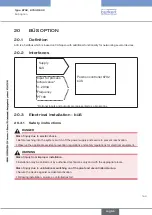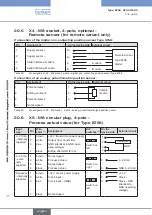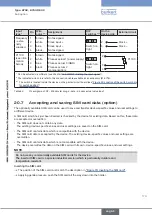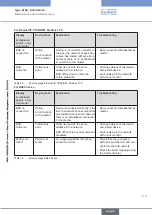
168
EtherNet/IP, PROFINET and Modbus TCP
Type 8792, 8793 REV.2
19.7.1
Differences between the fieldbus devices and devices without
a fieldbus
The following chapters of these operating instructions are not valid for Type 8792, 8793 with EtherNet.
•
Section
“Installation”
chapter
•
Section
“Start-up”
chapter
“14.3 INPUT - Setting the input signal”
•
Section “Auxiliary functions”
chapter “16.1.7 SPLTRNG – Signal split range”
chapter “16.1.17 CAL.USER – Calibration of actual value and set-
- menu option
calibr.INP
, calibration des set-point position
- menu option
calibr.SP,
calibration of the process set-point
chapter “16.1.15 BINARY.IN – Activation of the binary input”
chapter “16.1.16 OUTPUT – Configuration of the outputs (option)”
19.7.2
BUS.COMM –
Settings on Type 8792, 8793
Set the following menu options in the
BUS.COMM
menu for start-up of the EtherNet variant:
BUS FAIL
Activate or deactivate approach of the safety position
Selection
SafePos off
– The actuator remains in the position which corresponds to the set-point value
last transferred (default setting).
Selection
SafePos on
–
If there is a fault in the bus communication, the behavior of the actuator
depends on the activation of the
SAFEPOS
auxiliary function. See chapter
“16.1.13 SAFEPOS – Inputting the safety position”.
SAFEPOS
activated:
The actuator moves to the safety position which is specified in the
SAFEPOS
auxiliary function.
SAFEPOS
deactivated:
The actuator moves to the safety end position which it would assume if the
electrical and pneumatic auxiliary power failed.
See chapter “10.9 Safety end positions after failure of the electrical or pneu-
english



































